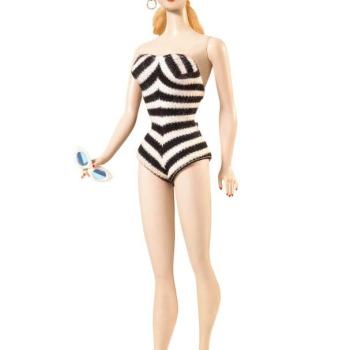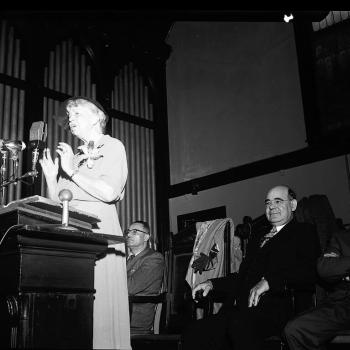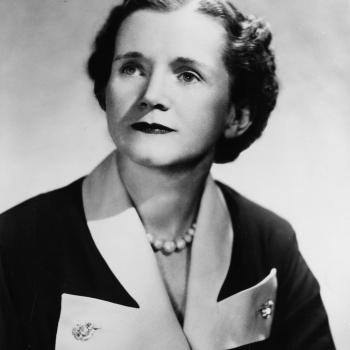
When Barbie was released in 1959, she immediately stepped into controversy. The idea of a doll with an adult woman's features was brand-new. The market, though, was eager for a doll with lots of clothes, including bridal gowns and swimsuits. But by the 1970s, people began wondering why she did not have a business suit or a doctor's scrubs, and in more recent years, whether the body image she presents is healthy to young girls' self-esteem. Sales continue to grow, and so does the debate.
While Barbie's collection of accessories has changed over the years, her figure has remained relatively unchanged-despite questions about its effect on the self-esteem of the children who play with the doll. Take this opportunity to explore body image and advertising:
- Have students bring in pictures from the magazines that they typically read. Students should bring pictures of both male and female subjects.
- Post these pictures around the room and have students walk around with a two-columned chart with headings Male and Female which they will use to record words and phrases that describe what they see in the pictures. Students should then share their lists with the class.
- Ask students to write about how gender is represented in the advertisements they see. Is this typical of how men or women appear in movies, on TV, etc.? Which celebrities most exemplify these characteristics?
- After sharing responses in a think-pair-share arrangement, have students explain whether these gender representations are accurate in real life. Ask students to consider the effect that these representations can have on people's self-esteem.
- Conclude by discussing why advertisers portray males and females in this way. What is the goal and purpose of advertising?
This History Channel article provides information about the origin and evolution of this famous doll.
PBS offers information about the inventor of Barbie.
BBC News shares Barbie's measurements and shows how a woman would look with Barbie's proportions.
Poets.org offers this poem by Denise Duhamel that compares Barbie to Buddha. Students will enjoy the sarcastic tone of this piece.

Our shared history unites families, communities, and nations. Although women's history is intertwined with the history shared with men, several factors - social, religious, economic, and biological - have worked to create a unique sphere of women's history. This year's theme is "Women Inspiring Innovation Through Imagination: Celebrating Women in Science, Technology, Engineering and Mathematics".
The stories of women's achievements are integral to the fabric our history. Learning about women's tenacity, courage, and creativity throughout the centuries is a tremendous source of strength. Until relatively recently, this sphere of women's history was overlooked and undervalued. Women's achievements were often distorted, disdained, and denied. But, knowing women's stories provides essential role models for everyone. And role models are genuinely needed to face the extraordinary changes and unrelenting challenges of the 21st century.
Explore the accomplishments of women in U.S. history with your class by creating a scrapbook that highlights the accomplishments of famous American women.
- First, decide how to organize the scrapbook. Group entries thematically, such as Women in Sports, Women in Politics, or Women in Science. Pages can be arranged chronologically, by date, year, or decade. Students may also choose a unique approach, such as Women's History A-Z, with an entry for each letter of the alphabet. Use the Alphabet Organizer to get started.
- Have students work individually, or in groups, to complete each page. Each entry should include biographical data, a photograph or other representation, and a summary of the famous woman's contribution to history. The Bio-Cube can be used to organize the information.
Your completed scrapbook can be displayed in the school library during Women's History Month and can serve as a reference tool in your classroom. You may also want to expand this activity to include women's contributions to world history.
This page, from the National Women's History Project, offers an annotated list of this year's honorees.
Scholastic presents this special feature on Women's History Month. There are profiles, a quiz, a history of this event, and a timeline of women's history milestones.
This Scholastic Webpage highlights the achievements of five women who have changed history, including Amelia Earhart, Rosa Parks, Sally Ride, Dr. Mae Jemison, and Melba Pattillo.
This resource, from the My Hero Project, includes information about women from all walks of life. Read about these artists, scientists, authors, educators, and other women who have made a difference.

The Irish have observed St. Patrick's Day as a religious holiday since the island's conversion to Christianity in the early Middle Ages. The first St. Patrick's Day parade in New York City took place on March 17, 1762, giving the Irish soldiers serving in the English military the opportunity to reconnect to their roots. Today, St. Patrick's Day is celebrated by people of varied backgrounds around the globe.
Celebrate St. Patrick's Day by reading Irish folk tales. It is the perfect opportunity to learn about Irish heritage. Have a selection of books available in class or bring students into the school media center to select an Irish folk tale. Tales are also available online from the Open Directory Project. Then have students read independently, in small groups, or as a class.
After reading the story, have your students use the ReadWriteThink Story Cube tool to create a graphic organizer. Older students can use the ReadWriteThink Literary Elements Map to map story elements. Have students print out their graphic organizers and share them with the class. After finishing this activity, treat your students to some Irish soda bread while they listen to Irish folk music.
Extend the activity by having students read additional Irish tales and compare them to other traditional folk tales with which they are familiar. What characteristics are unique to the Irish tales? Brainstorm common characters, settings, or themes found in the Irish tales. Students can then write their own tales in the Irish style.
Part of America's Story from America's Library, this site invites elementary students to read about the history of St. Patrick's Day from primary sources. Students can explore Irish folk songs and view historical photographs.
This History Channel website explores the culture and background of St. Patrick and St. Patrick's Day celebrations. The site's interactive map offers information on different parts of Ireland and beautiful photographs.
Resources offered on this official website of the Irish government include an extensive photograph collection of well-known locations in Ireland as well as information on culture, sports, the land, the people, and the economy.
This National Geographic News article focuses on some of the St. Patrick's Day traditions that are not actually Irish.

Our solar year is 365.24219 days. Since our calendar does not deal in partial days, every four years, we add an additional day to February. Therefore, our calendar year is either 365 days in nonleap years or 366 days in leap years. A leap year every four years gives us 365.25 days, sending our seasons off course and eventually in the wrong months. To change .25 days to .24219, we skip a few Leap Days every one hundred years or so.
Many years ago, people did not have the scientific information that we have available today to explain the change of seasons, the need for a Leap Day every four years, and the cycle of moon phases. Early civilizations relied on other means of explanation such as myths and folk tales.
Divide the class into groups and provide each group with an explanatory myth (e.g., the children's book Max and Ruby's First Greek Myth by Rosemary Wells or the works of Gerald McDermott or Tomie dePaola). Have students write summaries of the stories to share with the class. Then have the students in each group compose an original myth that explains either the same phenomenon from the book they summarized or another one of their choosing. Stories can be illustrated and collected into a book to share with other classes in the school.
This site explains things about Leap Year that are not common knowledge to most, has resources for party planning, and also includes a list of Leap Day books.
Wonder of the Day based on the student question “Why is there leap year?”
Intended for grade-school-level students, this NASA website recommended by SchoolZone has information about astronomy as well as projects, lesson ideas, and resources for the classroom.
This site from NASA, focusing on an image of a coin minted with Julius Caesar's likeness, provides a brief explanation of the origins of Leap Day. The site also references Sosigenes, the astronomer who consulted with Caesar on the calendar and invention of Leap Day.

Sidney Poitier was one of the first African Americans to win critical acclaim and awards for his acting performances, most notably in films such as In the Heat of the Night, Lilies of the Field, and Guess Who's Coming to Dinner. In addition to acting, Poitier has also worked in the film industry as a producer, writer, and director.
In her acceptance speech for the Academy Award for Best Actress in 2003, Halle Berry acknowledged the work of other African American actors and actresses, including Sidney Poitier. Discuss with students the importance of Poitier's role in bringing equality to African American actors, especially in the 1950s,1960s, and 1970s.
Through the years, many barriers have been broken-barriers of age, race, and gender, to name a few. Ask students to write in their journals about any barriers that might impede them in the future (e.g., language, class, disability), and about how they can break through those barriers now. Should students desire it, these journal pieces could be made public in the form of letters to the school or local newspaper or some other format.
This PBS website offers biographical information, an interview, film clips, and other information about Poitier's life and career.
In 1995, Poitier was honored by The John F. Kennedy Center for the Performing Arts for his contributions to film. This page offers information about Poitier's life and career.
The BBC offers the text of a 1964 report on Poitier's historic Oscar win, along with contextual information. Also included is an audio clip of Poitier discussing acting.
This resource from National Public Radio includes an April 2000 audio interview with Sidney Poitier from the Fresh Air radio program. In the interview Poitier discusses his role in In the Heat of the Night, as well as personal life experiences.

John Steinbeck, one of America's most noted authors and a Nobel laureate in 1962, gave voice to the plight of many different characters in his novels. The Grapes of Wrath, his Pulitzer Prize-winning novel, told of the terrible obstacles faced by the migrant workers who left the Dust Bowl and traveled west searching for work in California.
Steinbeck's works reflect the issues and ills of the time period in which he lived. The Grapes of Wrath, for example, deals with a group of migrant farm workers who moved from field to field. Often, these workers lived in squalid conditions and were paid poor wages. They were forced to purchase their supplies from a company store and then work to pay off their debt, many times without ever seeing a penny of their wages. Present students with information about the Dust Bowl and the flight of many farm workers west to California.
Ask students, "If Steinbeck were to write today about the ills of society, what topics or subjects might he find to address?" Brainstorm with the class a list of possible topics. Have groups of students each research a topic of their choosing and prepare an annotated bibliography of fiction and nonfiction texts that address the topic. The bibliographies can later be used as a school library resource.
The National Steinbeck Center is a museum in Salinas, California where Steinbeck was born. This site has information about his life and changing exhibits relating to his work and the time period during which he lived.
Nobelprize.org presents a brief biography of Steinbeck, along with the Nobel presentation speech and a short film of the event.
NPR provides this resource, which includes an audio report on the story behind the creation of The Grapes of Wrath.
This PBS website offers information about the American Experience film Surviving the Dust Bowl. There are also links to a teacher's guide, a timeline of events, a map, and related resources.
This article discusses Steinbeck's Grapes of Wrath within its historical context of the Dust Bowl.

Erma Bombeck was born in Dayton, Ohio, in 1927. Soon after the birth of her first daughter, she began writing a newspaper column called "At Wit's End," which was quickly picked up by newspapers across the country. Bombeck's largely autobiographical accounts of the "battles" between men and women and between children and parents, told with gentle yet sarcastic humor, became part of America's reading throughout the 1960s and 1970s. Bombeck died in 1996.
Many students have difficulty identifying or appreciating allusive or satirical humor. Using the following lines from Bombeck's newspaper column, ask students to identify not what they think is funny, but what someone else might find funny.
- Shopping is a woman thing. It's a contact sport like football. Women enjoy the scrimmage, the noisy crowds, the danger of being trampled to death, and the ecstasy of the purchase.
- There are two kinds of women who will spring big bucks for a make-up mirror that magnifies their faces. The first are young models who need to cover every eyelash, shadow their cheekbones, define their lips, and sculpt their faces. The second group are women who, without their glasses, cannot find their faces.
- I just clipped two articles from a current magazine. One is a diet guaranteed to drop five pounds off my body in a weekend. The other is a recipe for a 6-minute pecan pie.
- Most children's first words are "Mama" or "Daddy." My kid's first words were, "Do I have to use my own money?"
High school students can rewrite the passages to make them funny for a different audience.
This University of Dayton website is dedicated to Bombeck's life and work. The site includes several of her columns, as well as video clips from the short-lived sitcom called Maggie, which Bombeck developed.
This page features a biography and an interview with Bombeck from 1991. In the interview, she discusses her writing process, as well as influences on her life.
Just as Bombeck did in her syndicated newspaper column, Mark Twain used irony and sarcasm to tell his humorous stories. This PBS resource explores Twain's use of humor.

Rachel Carson, born on May 27, 1907, loved nature and had a lifelong desire to protect the environment. She was aware of the dangers of DDT and other chemicals and tried to educate the public through articles, pamphlets, and books. Her book Silent Spring warned about the poisons that were everywhere and heightened environmental awareness in people throughout the world.
Introduce your students to Rachel Carson by having a discussion about how chemicals can affect the environment. Show students a picture of a bald eagle and ask them if they have ever heard of DDT. DDT was a pesticide responsible for the decline of eagles in North America from more than half a million in 1872 to only 417 breeding pairs in 1973. At this point, either read a book about Rachel Carson to your class or have them find information about her on the websites listed below. After learning about Rachel Carson, invite students to choose one of these follow-up activities:
- Visit the Ecology Hall of Fame. Write an acrostic poem about one of the environmentalists or use the Bio-Cube interactive to summarize the person's biography.
- Explore the Environmental Movement Timeline. Research and add more recent events to this timeline with the ReadWriteThink Interactive Timeline.
- After researching environmental issues, write a Diamante Poem exploring a before-and-after vision of a particular habitat.
This website is "devoted to the life and legacy of Rachel Carson." It includes her biography, many primary documents, and excellent links.
After learning how DDT affected the eagle population, read about the U.S. laws that now protect eagles. Information about the recovery of bald eagles is also provided on this U.S. Fish and Wildlife Service site.
Learn about the decline of eagles and their recovery on this PBS Nature website. Visitors can view beautiful photographs and meet various members of the eagle family.
This page provides context and excerpts from Silent Spring. Rachel Carson's classic text has been called one of the most important works of the 20th century.

William Shakespeare is the most widely taught playwright in the English language. By 1588, Shakespeare had left his wife and children to live in London as an actor. During the next ten years, he became a successful playwright, performing for the royal court and building a new theater called the Globe. He retired to Stratford-upon-Avon in 1616, where he died soon after. Since that time, few young students of English literature have not heard the line, "O Romeo, Romeo! Wherefore art thou Romeo?"
Students at every grade level can be involved in activities to celebrate Shakespeare's birth.
Elementary students can begin learning about the rhyming structure of a sonnet by using one of the Websites below. They can also begin practicing with the number of syllables in a line.
Introduce middle school students who enjoy insulting one another to the Shakespearean Insult Kit, which includes a selection of Shakespearean invectives. They will gain confidence with the language as well as blow off some steam.
Demonstrate to high school students that Shakespeare always remains relevant through modern updates and reworkings. Select a short scene for your students to read from Othello (e.g., the scene where Iago first tells Othello that his wife might be unfaithful) and then watch the recent adaptation of that scene from the movie O, in which the main character is a basketball star. You can do the same with the sleepwalking scene from Macbeth, and have students watch its updated version in Men of Respect, a modern-dress gangster movie. On a lighter note, The Taming of the Shrew was updated in the movie 10 Things I Hate About You, in which the final party scene is similar, but modernized for a contemporary-and female-audience.
This award-winning website for younger students was created by elementary students at Crichton Park School in Nova Scotia. It contains a collection of materials related to Shakespeare, including resources for teachers.
This site is both an annotated guide to Shakespeare resources available on the Internet and a collection of original resources, including a comprehensive timeline of Shakespeare's life and work.
The Academy of American Poets provides this Shakespeare exhibit. Included are selected writings, biographical information, and links to related resources.
This website for the world's largest collection of Shakespeare's printed works contains authoritative articles on his life and work, as well as continually updated links to other related resources.

Ezra Jack Keats wrote and illustrated more than 85 children's books. His beautifully written and illustrated story, The Snowy Day, won a Caldecott medal in 1963. Peter, an African American child who is the hero of The Snowy Day, is the main character of seven other books by Keats.
Although Ezra Jack Keats had no formal training in art, his illustrations won many awards. As you read his books to your class, point out that his illustrations are a combination of painting and collage. In celebration of his birthday, invite your students to be authors and illustrators. Have them write their own stories that include some characters from Keats' books. The stories can be done individually or in groups. Ask students to bring in scraps of materials to create their collages.
Have students practice using collage techniques with the Collage Machine at the National Gallery of Art. Step through the pictures available in the tool to show the options for adding images to collages that go beyond color blocks. Look at the ways to manipulate the images (reducing or enlarging their size, flipping and layering images and so on) in order to demonstrate options students can explore in original collages.
The Ezra Jack Keats Foundation provides this resource, perfect for an author study on Keats. Students of all ages will enjoy reading his biography with photographs and hyperlinks. The page on tips and resources offers suggestions on using Keats' books to enhance literacy.
This online exhibit is provided by the de Grummond Children's Literature Collection at the University of Southern Mississippi. Visitors will find proofs for 37 books written and/or illustrated by Ezra Jack Keats, his personal papers, fan mail, and more! There is a link to Keats Across the Curriculum which includes activities and Internet resources for many of his books.
The Snowy Day is possibly one of Keats' best-known and beloved stories. This Teaching Heart webpage is filled with suggestions for teaching this children's literature classic.
Introduce a snowy day center with a three-step project.